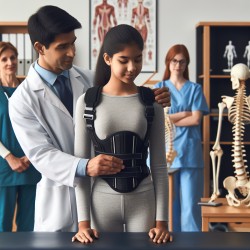Introduction
In the realm of adolescent idiopathic scoliosis, brace treatment is a cornerstone for preventing curve progression. However, adherence to this treatment remains a challenge, with many adolescents wearing their braces far less than the prescribed 20 to 23 hours per day. The negative impact on their quality of life often leads to an average wear time of just 12 hours daily. To address this, a recent study developed an Interprofessional Adherence Support (IPAS) intervention model aimed at enhancing brace adherence through a comprehensive, team-based approach.
Understanding the IPAS Model
The IPAS model is a result of extensive research and collaboration among health professionals, including orthopedists, physiotherapists, and psychologists. The model emphasizes a multi-tiered approach to support brace adherence by addressing educational, motivational, functional, psychological, and teamwork strategies. The ultimate goal is to improve the quality of life and treatment outcomes for adolescents with scoliosis.
Key Components of the IPAS Model
- Educational Strategies: Educating patients and their families about scoliosis and the importance of brace adherence is crucial. This includes debunking myths and providing clear, evidence-based information.
- Motivational Strategies: Building a strong patient-provider relationship and fostering peer support groups can significantly enhance motivation for adherence.
- Functional Strategies: Ensuring comfort and functionality of the brace through regular adjustments and progressive treatment approaches helps patients adapt more easily.
- Psychological Support: Offering psychological counseling and group sessions can address the emotional and social challenges faced by adolescents undergoing brace treatment.
- Interprofessional Teamwork: A collaborative approach involving various healthcare providers ensures comprehensive support and effective management of brace treatment.
Implementing the IPAS Model
For practitioners, implementing the IPAS model involves integrating these strategies into their practice. This requires collaboration with other professionals and a commitment to patient-centered care. Practitioners should also consider the unique needs of each patient, tailoring interventions to provide the most effective support.
Encouraging Further Research
While the IPAS model offers a promising framework for enhancing brace adherence, ongoing research is essential to refine and validate its effectiveness. Practitioners are encouraged to contribute to this body of research by sharing their experiences and outcomes with the model. By doing so, they can help improve the standard of care for adolescents with scoliosis.
To read the original research paper, please follow this link: Development of a model of interprofessional support interventions to enhance brace adherence in adolescents with idiopathic scoliosis: a qualitative study.










